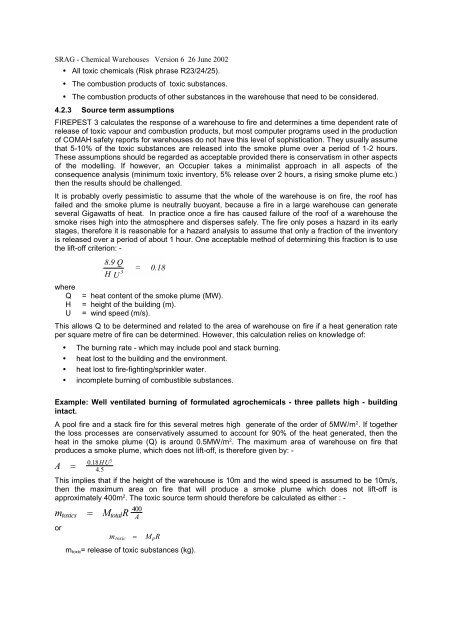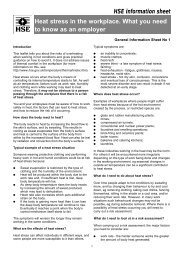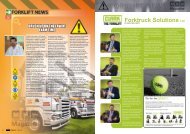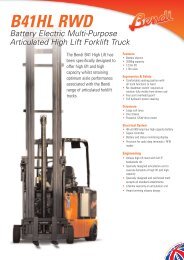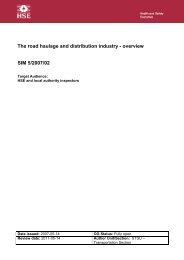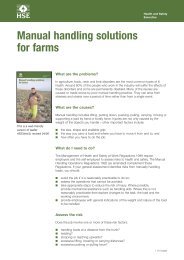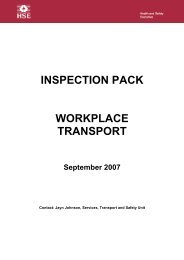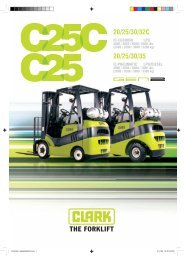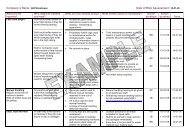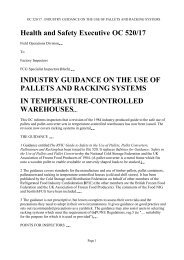Hazards - Forktruck Solutions Ltd.
Hazards - Forktruck Solutions Ltd.
Hazards - Forktruck Solutions Ltd.
You also want an ePaper? Increase the reach of your titles
YUMPU automatically turns print PDFs into web optimized ePapers that Google loves.
SRAG - Chemical Warehouses Version 6 26 June 2002 All toxic chemicals (Risk phrase R23/24/25). The combustion products of toxic substances. The combustion products of other substances in the warehouse that need to be considered.4.2.3 Source term assumptionsFIREPEST 3 calculates the response of a warehouse to fire and determines a time dependent rate ofrelease of toxic vapour and combustion products, but most computer programs used in the productionof COMAH safety reports for warehouses do not have this level of sophistication. They usually assumethat 5-10% of the toxic substances are released into the smoke plume over a period of 1-2 hours.These assumptions should be regarded as acceptable provided there is conservatism in other aspectsof the modelling. If however, an Occupier takes a minimalist approach in all aspects of theconsequence analysis (minimum toxic inventory, 5% release over 2 hours, a rising smoke plume etc.)then the results should be challenged.It is probably overly pessimistic to assume that the whole of the warehouse is on fire, the roof hasfailed and the smoke plume is neutrally buoyant, because a fire in a large warehouse can generateseveral Gigawatts of heat. In practice once a fire has caused failure of the roof of a warehouse thesmoke rises high into the atmosphere and disperses safely. The fire only poses a hazard in its earlystages, therefore it is reasonable for a hazard analysis to assume that only a fraction of the inventoryis released over a period of about 1 hour. One acceptable method of determining this fraction is to usethe lift-off criterion: -8.9 Q3H U= 0.18whereQ = heat content of the smoke plume (MW).H = height of the building (m).U = wind speed (m/s).This allows Q to be determined and related to the area of warehouse on fire if a heat generation rateper square metre of fire can be determined. However, this calculation relies on knowledge of: The burning rate - which may include pool and stack burning. heat lost to the building and the environment. heat lost to fire-fighting/sprinkler water. incomplete burning of combustible substances.Example: Well ventilated burning of formulated agrochemicals - three pallets high - buildingintact.A pool fire and a stack fire for this several metres high generate of the order of 5MW/m 2 . If togetherthe loss processes are conservatively assumed to account for 90% of the heat generated, then theheat in the smoke plume (Q) is around 0.5MW/m 2 . The maximum area of warehouse on fire thatproduces a smoke plume, which does not lift-off, is therefore given by: -A0.18HU 34.5This implies that if the height of the warehouse is 10m and the wind speed is assumed to be 10m/s,then the maximum area on fire that will produce a smoke plume which does not lift-off isapproximately 400m 2 . The toxic source term should therefore be calculated as either : -m toxics M total R 400Aorm toxic M p Rm toxic= release of toxic substances (kg).


